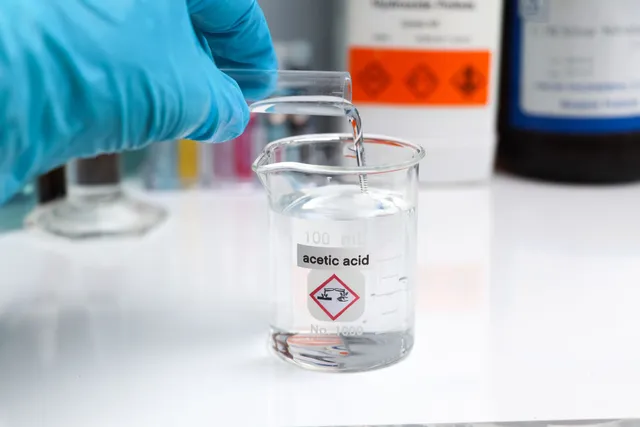Blog
Is Acetic Acid a Strong Acid pH? Exploring Acetic Acid Properties
When considering the question, “Is acetic acid a strong acid pH?”, it’s essential to understand the properties of acids and how they are measured. Acetic acid, with the chemical formula CH₃COOH, is a key player in various chemical reactions and processes. While it is often used in household products and cooking, its classification in terms of acidity can be confusing. This article will explore the pH of acetic acid, its strength compared to other acids, and the implications of its acidity in different contexts.
Understanding Acids: What Makes an Acid Strong or Weak?
To determine whether acetic acid is a strong acid, it’s important to first understand what defines an acid. Acids are substances that donate protons (H⁺ ions) in a solution. Strong acids completely dissociate in water, meaning they release all their protons, while weak acids only partially dissociate. This leads us to the question: where does acetic acid fit into this classification?
Acetic Acid pH: Learn How to Measure and Adjust pH Levels
Acetic Acid: A Weak Acid
It is classified as a weak acid. This classification arises because it does not fully dissociate in solution. In water, acetic acid only partially ionizes to produce acetate ions (CH₃COO⁻) and protons (H⁺). The chemical equilibrium can be expressed as follows:CH3COOH⇌CH3COO−+H+\text{CH}_3\text{COOH} \rightleftharpoons \text{CH}_3\text{COO}^- + \text{H}^+ CH3COOH⇌CH3COO−+H+
This means that in a solution of acetic acid, there are both undissociated acetic acid molecules and ions present. Therefore, acetic acid cannot be considered a strong acid like hydrochloric acid (HCl) or sulfuric acid (H₂SO₄), which fully dissociate in solution.
pH of Acetic Acid Solutions
The pH of a solution containing acetic acid depends on its concentration. Pure acetic acid has a pH of about 2.4, which may suggest it is strong; however, this value reflects the presence of hydrogen ions in the solution rather than complete dissociation.
When diluted in water, the pH increases, reflecting the weak nature of acetic acid. For instance, a 1 M solution of acetic acid will have a pH around 2.9, whereas a 0.1 M solution will have a pH closer to 3.1. This gradual change in pH illustrates how acetic acid behaves as a weak acid.
The Acid Ionization Constant (Ka) of Acetic Acid
To further analyze the strength of acetic acid, we can examine its acid ionization constant, denoted as Ka. For acetic acid, Ka is approximately 1.8×10−51.8 \times 10^{-5}1.8×10−5 at 25°C. This small value indicates that acetic acid does not ionize completely, supporting the assertion that it is a weak acid.
In contrast, strong acids have much larger Ka values, often greater than 1, indicating they dissociate almost entirely in solution. For example, hydrochloric acid has a Ka value that effectively approaches infinity, as it completely ionizes in water.
Comparing Acetic Acid with Strong Acids
To understand the practical implications of acetic acid’s weak acidity, we can compare it with strong acids. Strong acids, such as hydrochloric and sulfuric acids, are used in reactions that require a high concentration of hydrogen ions. These acids can lead to rapid pH changes in a solution and have corrosive properties.
In contrast, acetic acid is often utilized in cooking and food preservation due to its mild acidity. For example, vinegar, which contains about 5% acetic acid, has a much lower pH compared to other strong acids but is safe for consumption.
Applications of Acetic Acid in Various Fields
Acetic acid is prevalent in numerous applications beyond the kitchen. In the chemical industry, it is used as a solvent, a reagent in organic synthesis, and in the production of various chemicals such as vinegar, acetate, and plastics.
- Food Industry: Acetic acid is primarily found in vinegar, which is used for flavoring, preserving, and marinating. The low pH of acetic acid in vinegar helps inhibit the growth of certain bacteria, making it an effective preservative.
- Chemical Manufacturing: Acetic acid serves as a building block for the synthesis of various organic compounds. It is essential in producing acetic anhydride and acetates, which are vital in textiles, pharmaceuticals, and plastics.
- Pharmaceuticals: In pharmaceuticals, acetic acid is utilized in the production of various medicines and as a solvent for drug formulations.
Conclusion: Is Acetic Acid a Strong Acid?
In conclusion, the question “Is acetic acid a strong acid pH?” can be answered with clarity. Acetic acid is classified as a weak acid, primarily due to its incomplete dissociation in solution. Its pH varies based on concentration, illustrating its behavior as a weak acid in comparison to strong acids. Understanding these properties is crucial, especially in fields such as chemistry, food science, and pharmaceuticals.
Follow us on Facebook!

